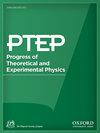The curious early history of CKM matrix -miracles happen!-
IF 8.3
4区 物理与天体物理
Q1 Physics and Astronomy
引用次数: 0
Abstract
The 1973 Kobayashi Maskawa paper proposed a compelling link between Cabibbo’s flavor-mixing scheme and ${\mathcal {C}}$${\mathcal {P}}$violation but, since it required the existence of six quarks at a time when the physics community was happy with only three, it received zero attention. However, two years after the paper appeared—at which time it had received a grand total of two citations—the charmed quark was discovered and it finally got some notice and acceptance. After this stumbling start, it subsequently emerged as the focal point of an enormous amount of experimental and theoretical research activity. In an invited talk at a KEK symposium to celebrate the 50th anniversary of the KM paper, I reviewed some of the less well known circumstances that occurred in the years preceding and following the paper’s appearance. Some spoilers: — Kobayashi and Maskawa (and a number of other Japanese physicists) were convinced about the existence of the charmed quark nearly three years before its “discovery” at Brookhaven and SLAC. — The matrix provided in their seminal 1973 paper was mathematically incorrect. Another version that was in common use for the following twelve years was technically correct, but not really a rotation matrix. — The CKM matrix ${\mathcal {C}}$${\mathcal {P}}$ phase was only measurable because of the very specific hierarchy of the flavor mixing angles and meson masses. — Similarly, the neutrino mixing discovery, and the PMNS-matrix measurability were only possible because of favorable values of the neutrino mass differences and mixing angles. In addition I include some speculations about what may be in store for the future.CKM 矩阵早期的奇特历史--奇迹发生了!--"。
1973年小林真川的论文提出了卡比布的味道混合方案与${mathcal {C}}${mathcal {P}}$违规之间令人信服的联系,但由于它要求存在六个夸克,而当时物理学界只对三个夸克感到满意,因此它没有得到任何关注。然而,在这篇论文发表两年后--当时它总共只被引用了两次--粲夸克被发现了,它终于得到了一些关注和认可。在蹒跚起步之后,它随后成为大量实验和理论研究活动的焦点。在庆祝 KM 论文发表 50 周年的 KEK 研讨会上,我应邀发表了演讲,回顾了论文发表前后几年发生的一些鲜为人知的情况。一些剧透:- 小林和真川(以及其他一些日本物理学家)在布鲁克海文和 SLAC "发现 "粲夸克的近三年前就确信了它的存在。- 他们在 1973 年的开创性论文中提供的矩阵在数学上是不正确的。在接下来的十二年里,另一个常用的版本在技术上是正确的,但并不是真正的旋转矩阵。- CKM矩阵的${mathcal {C}}${mathcal {P}}$相是可测量的,这是因为味道混合角和介子质量的层次非常特殊。- 同样,中微子混合的发现和PMNS矩阵的可测量性也只是因为中微子质量差和混合角的有利值才成为可能。此外,我还对未来可能发生的事情做了一些推测。
本文章由计算机程序翻译,如有差异,请以英文原文为准。
求助全文
约1分钟内获得全文
求助全文
来源期刊

Progress of Theoretical and Experimental Physics
PHYSICS, MULTIDISCIPLINARY-PHYSICS, PARTICLES & FIELDS
CiteScore
12.00
自引率
5.70%
发文量
148
审稿时长
17 weeks
期刊介绍:
Progress of Theoretical and Experimental Physics (PTEP) is an international journal that publishes articles on theoretical and experimental physics. PTEP is a fully open access, online-only journal published by the Physical Society of Japan.
PTEP is the successor to Progress of Theoretical Physics (PTP), which terminated in December 2012 and merged into PTEP in January 2013.
PTP was founded in 1946 by Hideki Yukawa, the first Japanese Nobel Laureate. PTEP, the successor journal to PTP, has a broader scope than that of PTP covering both theoretical and experimental physics.
PTEP mainly covers areas including particles and fields, nuclear physics, astrophysics and cosmology, beam physics and instrumentation, and general and mathematical physics.
 求助内容:
求助内容: 应助结果提醒方式:
应助结果提醒方式:


